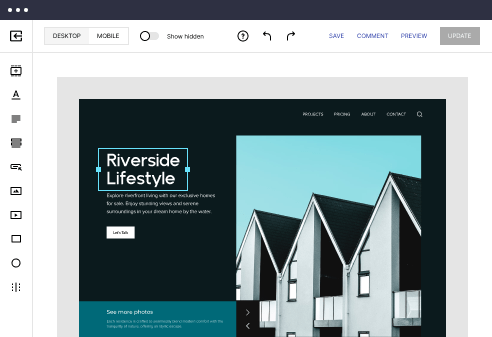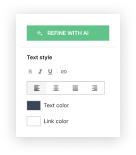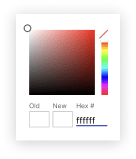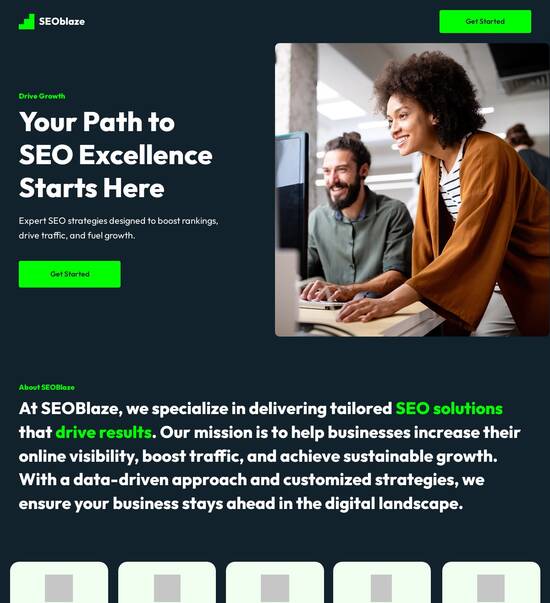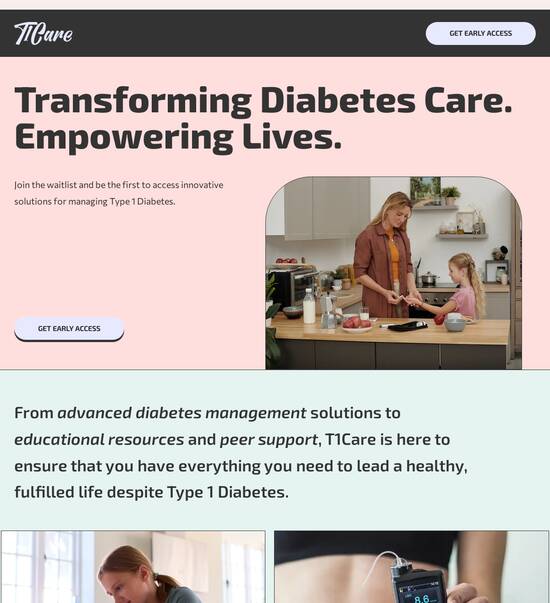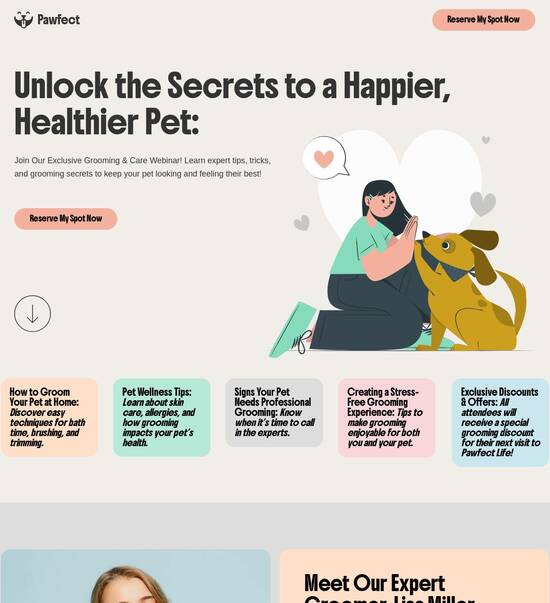
HTML page template for liquor stores
Use TemplateAbout template
Showcase your products with stunning landing page templates for your liquor stores. Ready to boost those sales?
Recommended templates
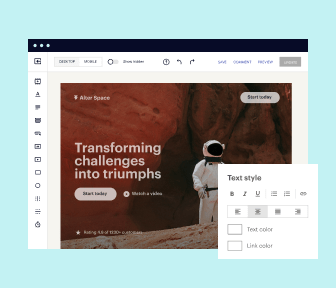
Easy to build without coding
With the intuitive drag-and-drop builder, anyone on your team can create high-converting pages without any knowledge of code or design. Make enhancements to your landing page with custom widgets using Javascript, HTML/CSS, or third-party scripts.
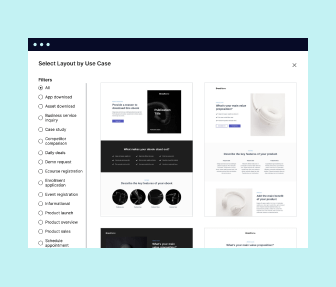
Multiple layouts for any industry and goal
Select from 500+ landing page layouts built to boost conversions across industry-specific scenarios. Customize them by adjusting fonts, adding images, and generating on-brand content with the AI assistant. Quickly scale with Instablocks® and Global Blocks that you can save, reuse, and update globally.

Loads fast and looks polished on any device
Every template is responsive, which means they present professionally on any device and load blazingly fast with our Thor Render Engine. You can also power them up with Google AMP technology to deliver an unparalleled mobile experience and drive higher conversions.
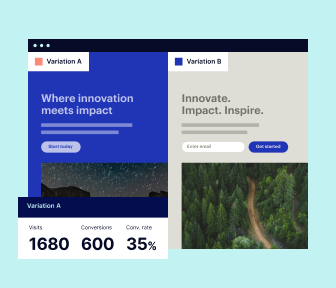
Robust analytics & experimentation
Get real-time updates and reporting across all your devices, showing the number of visitors, conversions, cost-per-visitor, and cost-per-lead. Launch AI-powered experiments, run A/B tests, and use heatmaps to analyze user behavior, then optimize your landing page to maximize conversions.
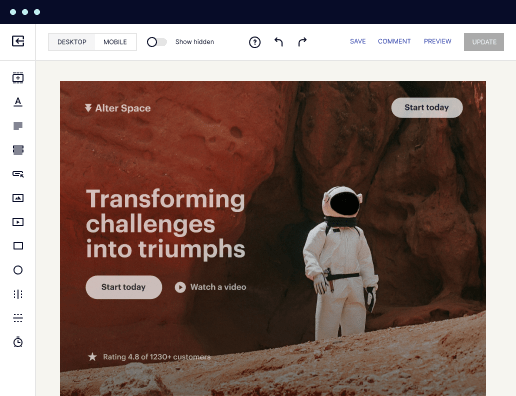
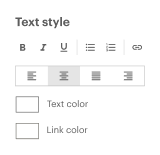
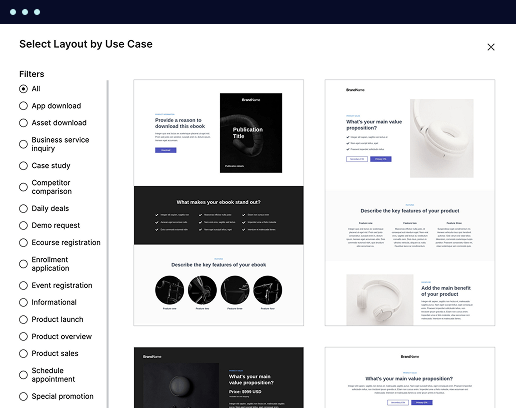

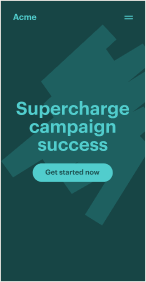
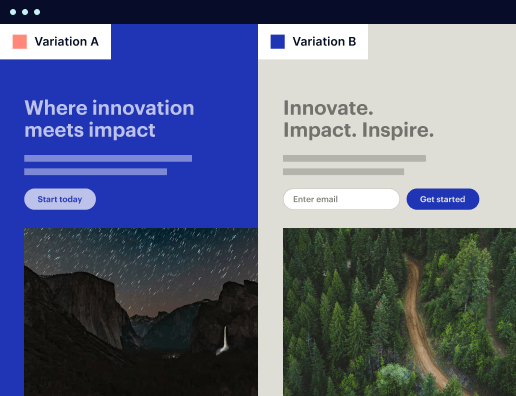
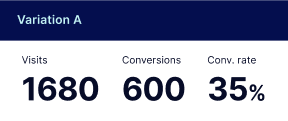
Easy to build without coding
With the intuitive drag-and-drop builder, anyone on your team can create high-converting pages without any knowledge of code or design. Make enhancements to your landing page with custom widgets using Javascript, HTML/CSS, or third-party scripts.
Multiple layouts for any industry and goal
Select from 500+ landing page layouts built to boost conversions across industry-specific scenarios. Customize them by adjusting fonts, adding images, and generating on-brand content with the AI assistant. Quickly scale with Instablocks® and Global Blocks that you can save, reuse, and update globally.
Loads fast and looks polished on any device
Every template is responsive, which means they present professionally on any device and load blazingly fast with our Thor Render Engine.
Robust analytics & experimentation
Get real-time updates and reporting across all your devices, showing the number of visitors, conversions, cost-per-visitor, and cost-per-lead. Launch AI-powered experiments, run A/B tests, and use heatmaps to analyze user behavior, then optimize your landing page to maximize conversions.
All the features you need to build liquor store web design
Explore more featuresLearn how to build best practices for mobile friendly liquor store website layouts
Frequently asked questions about liquor store website template
Leading the way in building high-performing landing pages





The ultimate guide to landing page optimization with Instapage
Optimizing your landing pages is critical for achieving the best return on investment (ROI) in your digital marketing efforts. Instapage's powerful features empower marketers to accelerate their campaigns, enabling them to create high-converting landing pages efficiently. In this guide, we'll walk through the steps to harness Instapage for effective optimization and highlight its value for various industries including tech, education, and financial services.
Understanding the basics of landing pages
Landing pages are standalone web pages, designed with a single purpose in mind: to drive visitors to take a specific action, such as filling out a form or making a purchase. When leveraging Instapage, it’s essential to understand how these pages can be effectively built and optimized. Here are the core attributes that define a successful landing page:
- Clarity: Your value proposition should be clear and immediately captured in the headline and subheading.
- Relevance: The content must align with the visitors' needs and expectations based on the ads they clicked to reach the page.
- Call-to-Action (CTA): Every landing page should feature a strong and prominent CTA that guides users toward the next step.
Choosing the right templates for your campaign
Instapage offers an extensive library of over 100 high-converting templates. Selecting a template that closely matches your campaign's objectives can significantly impact your conversion rates. Here’s how you can choose effectively:
- Identify your target audience needs: Select templates designed for specific sectors such as education or tech, ensuring they fit your users' expectations.
- Evaluate the call-to-action placements: Ensure that your chosen template highlights CTAs effectively to prompt conversions.
- Test different designs: Use A/B testing features to find which template resonates best with your audience.
Optimizing for conversions with experimentation
Once you’ve built your landing page, optimization starts with testing different variables to see what works best. Instapage simplifies this process with built-in experimentation features. Consider the following strategies:
- Run A/B tests: Experiment with different headlines, images, and layouts to determine which version leads to higher conversions.
- Utilize heatmaps: Detailed analytics will provide insights into user interactions on your page, allowing you to refine and tailor your approach.
- Continuously analyze performance: Leverage the analytics dashboard to monitor which elements of your landing page contribute to conversions.
In summary, using Instapage to create and optimize landing pages can take your digital marketing to the next level. By understanding the elements of effective landing pages, making informed design choices, and applying rigorous testing, you’ll scale your campaigns effectively.
Ready to optimize your landing pages? Start your journey with Instapage today and watch your campaigns thrive!
Crafting the perfect HTML page template for liquor stores: A comprehensive guide
The rise of e-commerce in liquor retail
The liquor store industry has witnessed significant transformation over recent years, particularly with the rise of e-commerce. A shift in consumer preferences towards online shopping has been observed, presenting opportunities for liquor retailers to reach a wider audience. This shift has been driven largely by the convenience that online shopping provides, making it easier for customers to browse and purchase products from home.
Recent statistics highlight a notable increase in online liquor sales, with many traditional liquor stores now exploring the digital landscape. This change is indicative of a broader trend within various retail sectors, yet it poses unique challenges and opportunities for liquor stores, particularly regarding compliance with local laws and consumer preferences.
E-commerce liquor sales have grown significantly, with estimates suggesting a compound annual growth rate of over 10%.
Changing consumer behavior trends, including preference for home delivery and varied product selection, are driving growth.
Increased competition from both local and national online retailers necessitates a robust online presence for liquor stores.
Exploring the anatomy of an effective liquor store website
A successful e-commerce platform for liquor stores must incorporate several core elements to ensure an optimal shopping experience. Key factors include user-friendly navigation, where products are easily categorized by type, brand, or occasion, allowing customers to quickly locate what they are looking for. High-quality images and product descriptions also play a vital role, as they help to inform and entice potential buyers, fostering engagement on the site.
Additionally, secure payment gateways are absolutely essential to instill confidence in customers. With increasing concerns over online security, retailers must prioritize the functionality of their payment systems to encourage transactions. A well-designed liquor store website should also include specific features such as age verification mechanisms to ensure compliance with legal regulations, alongside special promotions that attract customers to choose their website over competitors.
User-friendly navigation with clear product categories.
High-quality imagery and descriptive content for each product.
Secure and reliable payment gateways.
Age verification mechanisms to comply with regulations.
Display of special promotions and loyalty programs.
HTML5: The foundation for modern e-commerce liquor stores
HTML5 is an excellent choice for building liquor store templates due to its versatility and support for multimedia content. With its enhanced capabilities, HTML5 allows for rich media integration, such as videos and audio, which can be compelling in showcasing brands or providing tutorials related to products. This multimedia support enhances the overall shopping experience and engages customers.
Additionally, HTML5's responsiveness ensures compatibility across a range of devices, including desktops, tablets, and smartphones. As more consumers utilize mobile devices for shopping, responsive design becomes paramount in retaining customer interest and providing seamless navigation. Additionally, critical HTML5 elements allow for intuitive layouts that accommodate various types of content, ensuring that visitors are not only engaged but also informed.
Support for rich multimedia content enhances user engagement.
Responsive design capabilities ensure accessibility across devices.
Semantic markup improves content organization and search engine visibility.
The power of CSS3 in crafting engaging layouts
CSS3 significantly enhances the user experience on liquor store websites by enabling sleek and visually appealing designs. With CSS3, liquor stores can incorporate custom animations and transitions, making product displays more engaging and interactive. Instead of static images, animated effects can draw attention to special offers or new products, guiding customers through product selections.
Furthermore, CSS3 offers powerful layout techniques such as grid and flexbox layouts to create organized and aesthetically pleasing designs. These layouts enable easy adaptability to various screen sizes and orientations, which is essential for maintaining a consistent user experience on different devices. Careful consideration should also be given to the color palette and typography choices that align with the liquor store's brand identity to create an inviting atmosphere.
Custom animations create an engaging shopping experience.
Grid and flexbox layouts promote effective design organization.
Thoughtful color and typography enhance brand identity.
Building a Bootstrap-driven website for liquor stores
Utilizing the Bootstrap framework for liquor store websites comes with significant advantages. Bootstrap allows for rapid layout design, offering pre-built components that can streamline the development process. For liquor retailers, this means being able to set up an attractive and functional online store more quickly and efficiently than starting from scratch.
The mobile-first approach inherent in Bootstrap ensures that websites are optimized for smartphones and tablets, catering to the shopping habits of a broader customer base. Custom Bootstrap components can be tailored to meet the specific needs of liquor stores, such as navigation menus that direct customers to their preferred categories of liquor or product cards that highlight essential product information visually.
Rapid design capabilities reduce development time significantly.
Mobile-first approach ensures accessibility for all users.
Custom components tailored for product categories improve navigation.
Design aspects to attract and retain customers
User-centered design principles play a critical role in creating an effective liquor store template. A balance between aesthetics and functionality is essential; thus, a design should draw in visitors while making it easy for them to find what they need. Visual hierarchy can be enhanced with a strategic use of whitespace, making key elements stand out and guiding the customer’s eye through the site.
Moreover, the shopping experience must be enjoyable, making every click a pleasure. This can be achieved through the prominent placement of calls to action (CTAs) that encourage customer interaction. Moreover, providing intuitive search functionalities tailored to liquor selections helps streamline the process, making it easy for visitors to navigate directly to specific products or categories.
Balancing aesthetics and functionality maximizes overall impact.
Effective visual hierarchy guides customers and enhances usability.
Strategically placed CTAs encourage user interaction and conversions.
Effective code structure for enhancing performance
Optimizing HTML code for speed and efficiency is crucial for improving the overall performance of a liquor store website. Clean and maintainable code not only enhances loading times but also makes future updates and modifications easier. Additionally, attention should be given to image and asset optimization, ensuring that all visual elements load quickly without compromising quality.
SEO considerations also play a significant role in enhancing visibility on search engines. Implementing semantic markup can improve search engine understanding of content, leading to better rankings. Furthermore, utilizing meta tags and descriptions tailored to liquor products ensures that potential customers can easily find what they’re looking for in search results.
Focus on clean and maintainable code for faster loading times.
Image optimization is crucial for performance without quality loss.
Employing semantic markup improves search engine visibility.
Leveraging customer reviews and social proof
In the competitive world of online liquor sales, building trust through user-generated content like customer reviews is essential. Implementing review sections on product pages allows new customers to make informed decisions based on past buyer experiences. Encouraging customer feedback and star ratings enhances credibility and reassures potential buyers, making them more likely to proceed with a purchase.
Additionally, integrating social media into the website can extend engagement beyond the store. Showcasing user-generated content from social media platforms provides an authentic glimpse into customer experiences and fosters a community around the brand. Linking mentions and posts that highlight products can drive traffic from social channels back to the online store, creating opportunities for sales.
User reviews on product pages increase purchase confidence.
Encouraging feedback promotes engagement and trust.
Social media integration enhances brand awareness and community bonding.
Analyzing visitor behavior and enhancing user engagement
To fully harness the potential of online sales, liquor stores must analyze visitor behavior accurately. Utilizing analytics tools enables store owners to gain insights into customer interactions on their website, helping identify what products or sections are most engaging. Key metrics to track include page views, bounce rates, and average time spent on site, all of which inform strategic adjustments to enhance customer experience.
A/B testing is another critical aspect of improving user engagement continuously. By comparing two versions of a webpage, liquor retailers can identify which elements perform better and make informed design changes based on data. This iterative design approach is vital for refining the user experience, as evidenced by various case studies showcasing successful A/B tests within similar e-commerce frameworks.
Analytics tools offer insights into customer behavior and preferences.
Tracking key metrics helps in understanding user engagement levels.
A/B testing allows for strategic improvements based on real performance data.
Integrating e-commerce solutions for comprehensive functionality
When setting up an online liquor store, selecting the right e-commerce platform is paramount. Popular options such as Shopify or WooCommerce each offer distinct advantages tailored to various business needs. Liquor store owners must consider their specific operational requirements, such as inventory management and payment processing, when choosing a solution to ensure optimal functionality.
Beyond the selection of an e-commerce platform, enhancing customer functions is pivotal. Streamlining the shopping cart experience can reduce abandonment rates, so liquor stores must ensure that the checkout process is intuitive and efficient. The goal should be to create an environment where customers feel secure and confident about completing their transactions, subsequently minimizing drop-offs during purchase.
Choosing the right e-commerce platform ensures operational efficiency.
Streamlined shopping cart experience reduces cart abandonment.
Efficient checkout processes enhance customer satisfaction.
The future of liquor store websites
As the liquor retail landscape continues to evolve, emerging technologies and trends will shape the future of liquor store websites. For instance, advancements in artificial intelligence (AI) can play a vital role in personalizing shopping experiences based on individual customer preferences and behaviors. Such technologies offer retailers opportunities to curate recommendations that resonate with each user, creating a tailored shopping experience.
Moreover, it's essential for liquor store owners to stay ahead of the curve regarding changes in regulations and market demand. Keeping up-to-date with liquor laws and compliance issues is vital to ensure continued operation in an evolving landscape. Adapting to shifting customer preferences, including increasing demand for organic and locally sourced products, will also be imperative in maintaining relevance and competitiveness within the market.
AI technologies enhance personalized shopping experiences.
Staying informed on regulatory changes ensures compliance and protection.
Adapting product offerings to meet evolving consumer preferences is key for competitiveness.
Summary of key takeaways
Building a strong online presence for liquor stores involves a multifaceted approach that integrates design, functionality, and customer engagement strategies. By focusing on core components like user-friendly navigation, compelling visuals, and optimized performance, liquor retailers can create a shopping experience that converts visitors into loyal customers.
Moreover, leveraging modern technologies and adhering to regulatory standards further empowers liquor stores to thrive in the online marketplace. By considering the evolving demands of consumers and employing best practices in e-commerce, liquor store websites can maximize their reach and impact in this vibrant industry.
Ready to skyrocket conversions?
Supercharge your ad campaigns with high-performing landing pages
Get started